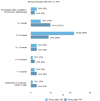Does Total Neoadjuvant Therapy Impact Surgical Precision in Total Mesorectal Excision? A Nationwide Survey of the Experiences of Expert Surgeons
- PMID: 39858065
- PMCID: PMC11763819
- DOI: 10.3390/cancers17020283
Does Total Neoadjuvant Therapy Impact Surgical Precision in Total Mesorectal Excision? A Nationwide Survey of the Experiences of Expert Surgeons
Abstract
Background: The treatment of locally advanced rectal cancer (LARC) has steadily progressed over the past four decades, with recent focus shifting towards total neoadjuvant therapy (TNT). This survey aims to elucidate the perceived surgical challenges faced by Austrian colorectal surgeons performing total mesorectal excision (TME), focusing on the increased complexity and surgical difficulty introduced by intensified treatment regimens.
Methods: A comprehensive survey was conducted among Austrian colorectal surgeons to explore various aspects of managing and performing TME following TNT. The survey included questions on the general management of LARC within their institutions and utilized a five-point Likert scale to assess the respondents' perceptions and experiences regarding surgical precision and post-operative morbidity associated with TNT.
Results: A total of 31 surgeons (54% response rate) completed the survey. Regarding multidisciplinary therapy preferences, 56% of respondents preferred conventional neoadjuvant therapy regimens, with 32% favoring chemoradiotherapy and 24% opting for short-course radiotherapy, while 31% chose TNT. The majority of respondents (65%) reported quality differences in tissue dissection during TME following TNT, with 57% experiencing difficulties in identifying tissue planes and 47% noting increased tissue fragility. Increased bleeding was reported by 32% of respondents. In cases of regrowth after a watch-and-wait approach, 64% observed quality changes in tissue dissection, and 47% noted tissue fragility.
Conclusions: The survey results indicate that TNT impairs surgical precision due to changes in tissue quality and challenges in identifying surgical planes. Given the critical importance of surgical precision in achieving low local recurrence rates in mid-to-low LARC, these challenges could significantly impact patient outcomes. Further prospective studies are required to elucidate the extent of these effects.
Keywords: TME; TNT; neoadjuvant chemoradiotherapy; rectal cancer; surgical precision; total mesorectal excision; total neoadjuvant therapy.
Conflict of interest statement
The authors declare no conflicts of interest.
Figures













References
-
- Lasson A.L., Ekelund G.R., Lindström C.G. Recurrence risk after stapled anastomosis for rectal carcinoma. Acta Chir. Scand. 1984;150:85–89. - PubMed
LinkOut - more resources
Full Text Sources
Miscellaneous

